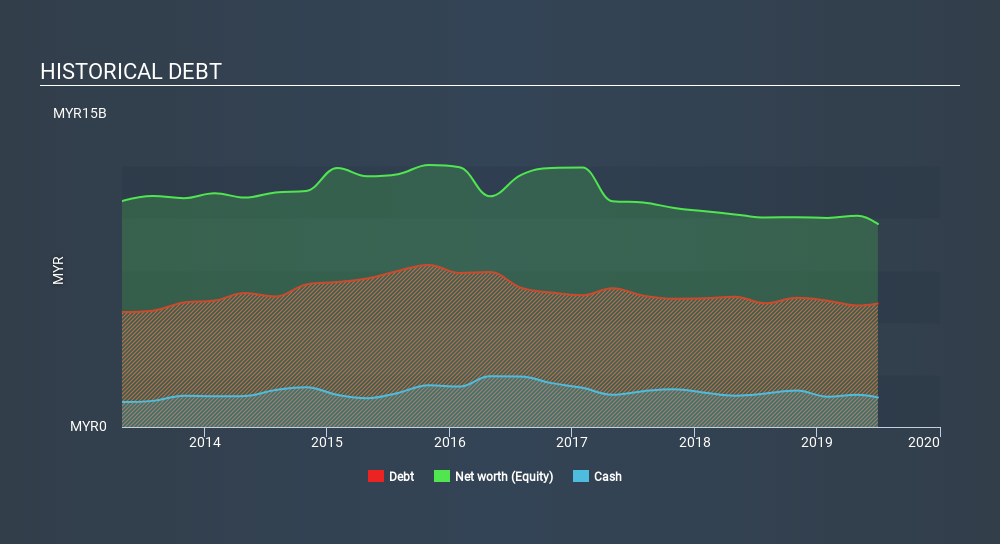- Malaysia
- /
- Industrials
- /
- KLSE:BJCORP
Does Berjaya Corporation Berhad (KLSE:BJCORP) Have A Healthy Balance Sheet?

The external fund manager backed by Berkshire Hathaway's Charlie Munger, Li Lu, makes no bones about it when he says 'The biggest investment risk is not the volatility of prices, but whether you will suffer a permanent loss of capital. So it might be obvious that you need to consider debt, when you think about how risky any given stock is, because too much debt can sink a company. Importantly, Berjaya Corporation Berhad (KLSE:BJCORP) does carry debt. But should shareholders be worried about its use of debt?
Why Does Debt Bring Risk?
Generally speaking, debt only becomes a real problem when a company can't easily pay it off, either by raising capital or with its own cash flow. If things get really bad, the lenders can take control of the business. However, a more usual (but still expensive) situation is where a company must dilute shareholders at a cheap share price simply to get debt under control. Of course, debt can be an important tool in businesses, particularly capital heavy businesses. When we think about a company's use of debt, we first look at cash and debt together.
See our latest analysis for Berjaya Corporation Berhad
How Much Debt Does Berjaya Corporation Berhad Carry?
As you can see below, Berjaya Corporation Berhad had RM5.91b of debt, at June 2019, which is about the same the year before. You can click the chart for greater detail. However, it does have RM1.42b in cash offsetting this, leading to net debt of about RM4.50b.

How Strong Is Berjaya Corporation Berhad's Balance Sheet?
The latest balance sheet data shows that Berjaya Corporation Berhad had liabilities of RM4.90b due within a year, and liabilities of RM5.19b falling due after that. Offsetting this, it had RM1.42b in cash and RM1.15b in receivables that were due within 12 months. So its liabilities total RM7.52b more than the combination of its cash and short-term receivables.
The deficiency here weighs heavily on the RM1.21b company itself, as if a child were struggling under the weight of an enormous back-pack full of books, his sports gear, and a trumpet. So we'd watch its balance sheet closely, without a doubt. After all, Berjaya Corporation Berhad would likely require a major re-capitalisation if it had to pay its creditors today.
We use two main ratios to inform us about debt levels relative to earnings. The first is net debt divided by earnings before interest, tax, depreciation, and amortization (EBITDA), while the second is how many times its earnings before interest and tax (EBIT) covers its interest expense (or its interest cover, for short). Thus we consider debt relative to earnings both with and without depreciation and amortization expenses.
Berjaya Corporation Berhad shareholders face the double whammy of a high net debt to EBITDA ratio (6.9), and fairly weak interest coverage, since EBIT is just 1.6 times the interest expense. The debt burden here is substantial. On a slightly more positive note, Berjaya Corporation Berhad grew its EBIT at 17% over the last year, further increasing its ability to manage debt. There's no doubt that we learn most about debt from the balance sheet. But it is Berjaya Corporation Berhad's earnings that will influence how the balance sheet holds up in the future. So when considering debt, it's definitely worth looking at the earnings trend. Click here for an interactive snapshot.
Finally, a company can only pay off debt with cold hard cash, not accounting profits. So the logical step is to look at the proportion of that EBIT that is matched by actual free cash flow. In the last three years, Berjaya Corporation Berhad's free cash flow amounted to 34% of its EBIT, less than we'd expect. That weak cash conversion makes it more difficult to handle indebtedness.
Our View
To be frank both Berjaya Corporation Berhad's net debt to EBITDA and its track record of staying on top of its total liabilities make us rather uncomfortable with its debt levels. But on the bright side, its EBIT growth rate is a good sign, and makes us more optimistic. We're quite clear that we consider Berjaya Corporation Berhad to be really rather risky, as a result of its balance sheet health. For this reason we're pretty cautious about the stock, and we think shareholders should keep a close eye on its liquidity. When analysing debt levels, the balance sheet is the obvious place to start. However, not all investment risk resides within the balance sheet - far from it. For instance, we've identified 2 warning signs for Berjaya Corporation Berhad that you should be aware of.
If, after all that, you're more interested in a fast growing company with a rock-solid balance sheet, then check out our list of net cash growth stocks without delay.
If you spot an error that warrants correction, please contact the editor at editorial-team@simplywallst.com. This article by Simply Wall St is general in nature. It does not constitute a recommendation to buy or sell any stock, and does not take account of your objectives, or your financial situation. Simply Wall St has no position in the stocks mentioned.
We aim to bring you long-term focused research analysis driven by fundamental data. Note that our analysis may not factor in the latest price-sensitive company announcements or qualitative material. Thank you for reading.
About KLSE:BJCORP
Berjaya Corporation Berhad
Provides consumer marketing, direct selling, and retailing services.
Mediocre balance sheet and slightly overvalued.
Similar Companies
Market Insights
Community Narratives



